




Vacation in Paris Blog
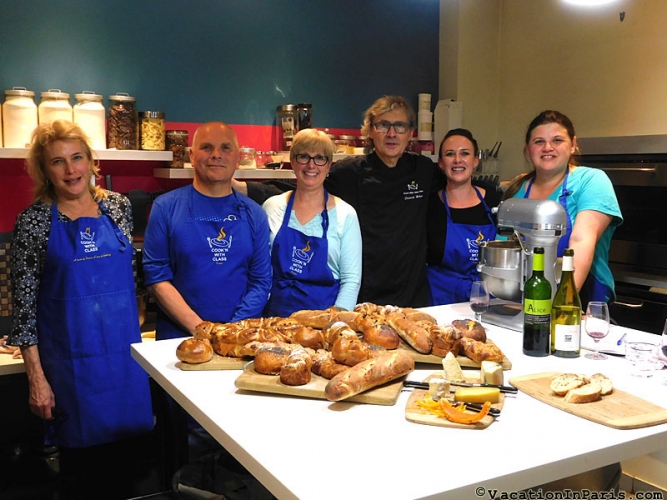
Cook'n With Class
Places To Visit - Posted on Apr 18,2017 by Hampton*Jan
I am not a natural cook. I don’t measure, I don’t pay attention to oven settings, and I never put on the timer. I’m the type that pulls out strands of spaghetti to decide when it’s done; who makes cookies, each time changing the amount of flour, sugar and butter as an experiment. Half the time my meals are a disaster; burnt, over salted or too spicy. Not to mention the mess I face after my cooking sprees. I was the perfect customer for Cook’n With Class. At the end of the class, I left, having learned not only how to make delicious French bread, but about the basics of cooking, as well as some interesting French history. It also reminded me what I love about France.
Situated on a narrow Parisian street in the 18th arrondissement, the Cook'n With Class space is sunny and relaxed. I was immediately put at ease by Yetunde, the owner’s wife and sales & marketing director, who greeted us warmly. As it was just 9am, we were told to help ourselves to coffee. I thought three hours of class might be long, so I poured myself a large mug. It turned out that the time flew by.
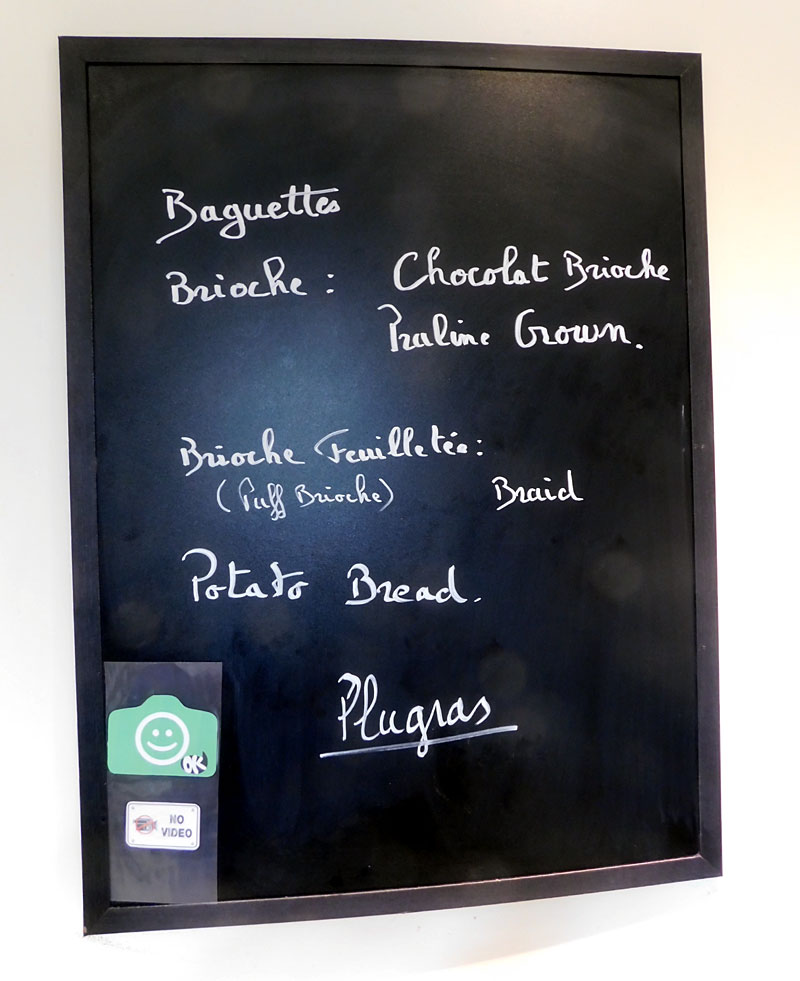
Our teacher and chef was Patrick, a charming Frenchman with wavy grey hair and a slight French accent. He had owned his own restaurant in Shreveport, Louisiana for twenty years, and is now one of the six full-time employees at Cook'n With Class. There were five of us: an Australian woman, a German woman, an American couple and myself. We’d be making four different types of bread. With aprons on, we stood around a large square table in one of the three ateliers, all of them professionally equipped with the latest appliances, and all sparkling clean.
Patrick started by showing us the importance of preparing in advance. He had measured each ingredient into small metal bowls: the water, the flour, and the yeast. A scale sat nearby. He showed us how we’d keep the surface clean at all times and I listened attentively.
With bread making, it’s all in the chemistry, he said. The measurements and temperature are crucial. How you manipulate the dough contributes to how the bread will turn out. That must be why so many of my experiments have ended up as disasters, I thought. I wasn’t respecting the natural chemistry of things. I wasn’t careful, haphazardly throwing things into the pot, hoping for the best.
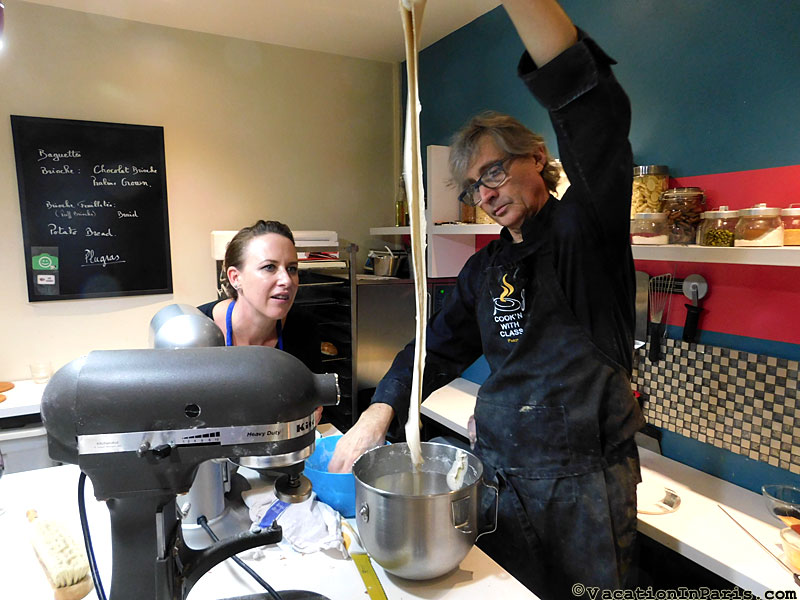
We crumpled the live yeast into the flour and water as Patrick explained that the yeast adds gas to the dough. It’s that lightness that makes a baguette nice and fluffy with pockets of air. During the preparation process, you want to protect this yeast effect by creating tension in the dough so that it retains those pockets of gas.
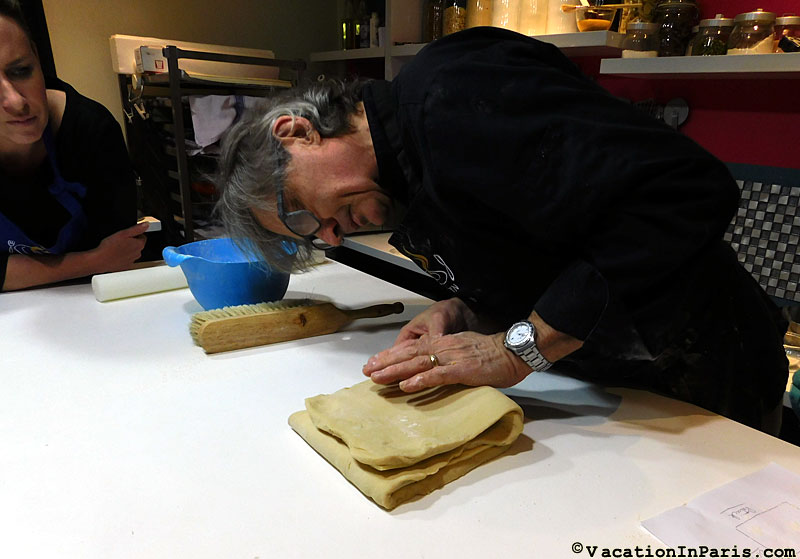
As we squeezed and kneaded the dough, then stretched it out, we tested the texture to see if it could spread so thin that we could almost see through it without breaking. Then we let the machine do the hard work. As it kneaded the dough roughly, the machine traveled across the table, flapping and banging the dough from side to side. It’s good to be rough with bread dough, Patrick said, the rougher the better. We took turns holding the machine in place, while Patrick talked to us about the quality of the ingredients. You must use a flour high in gluten, which makes the dough more elastic. Butter for the brioche dough must have a fat level of 82%, and, unlike other butters, French butter is slightly fermented giving it that unique taste, not easy to find outside of France. Like salt, I thought to myself, like many other things that can only be found in France.
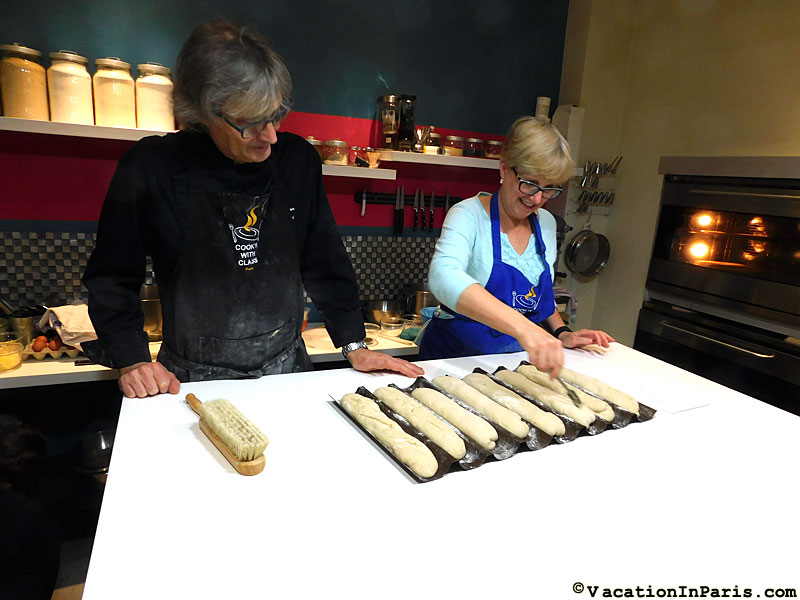
As we helped Patrick roll the dough out, he explained that in the 1980's and 90's the quality of baguettes in France plunged, upsetting the French population. Understandably, I thought. The baguette is their staple, it’s the symbol of France, it’s their beret, their perfume, their glass of Bordeaux! The government then took action and made legal requirements concerning the quality of ingredients. Therefore, now when you buy a baguette you can be sure it is of the highest quality. Make sure you ask for a “tradition” though. I couldn’t help but smile. Certain things are so important here: eating for one, aesthetics number two. For the French it is outrageous to skimp on the quality of life’s pleasures.
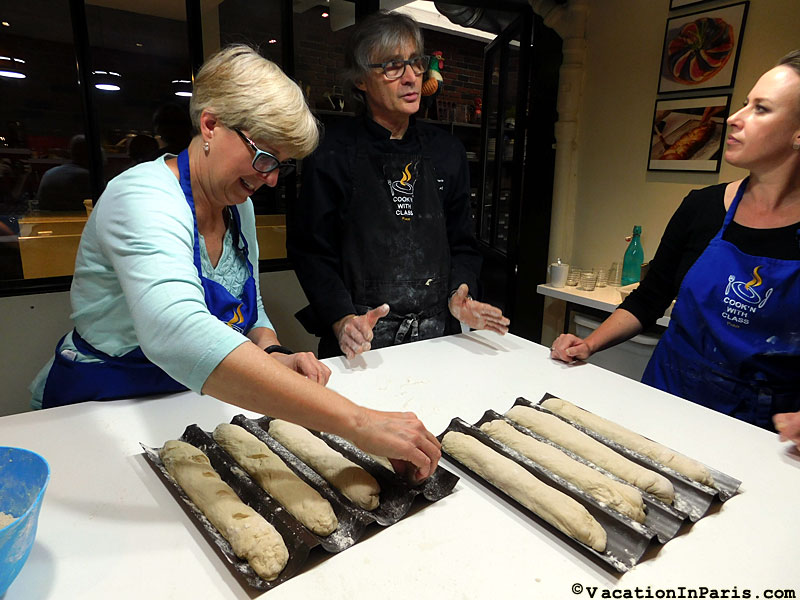
We then learned how to shape the dough into a bowl shape by tucking the edges under, making it taut, creating that tension again to hold the gas in, then covering it with a moist cloth. Later, a different sort of tension is required when shaping the baguette, but this time it’s important to minimize manipulation by pushing the dough in a certain way with your fingertips, then gently pulling out into the baguette shape. The final touch before it goes in the oven was a slit over the top of the baguette dough with a sharp razor.
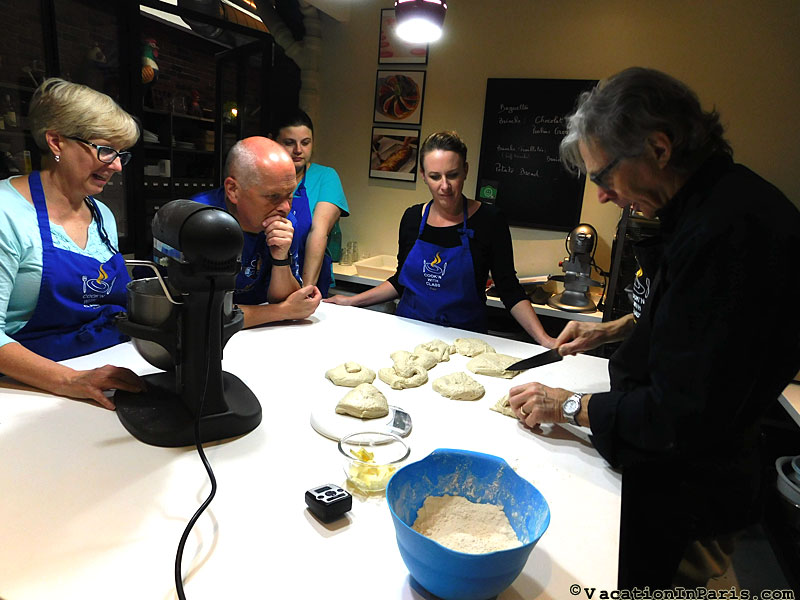
It was all subtle: the tension, sometimes forceful, sometimes gentle, the exactitude, and the seriousness. There is skill and aesthetics involved, yet also something creative going on, something whimsical. I love that about the French. Their methods are complex and ever so subtle, just like they are as a people: complex, discreet, and multi-layered. They are creators of beauty, even though there are clear rules underneath. It’s taken years for me to come close to understanding them. Perhaps this bread making class has brought me a little bit closer.
The class was moving along fast. We’d kneaded, we’d pulled, we’d rolled the dough out, pressing the rolling pin with our body weight, learning how to use the rolling pin as a sophisticated tool. We’d even made braids of the dough. That’s when Patrick joked, “open the legs,” as we pulled open the outer strands of dough, making us laugh.
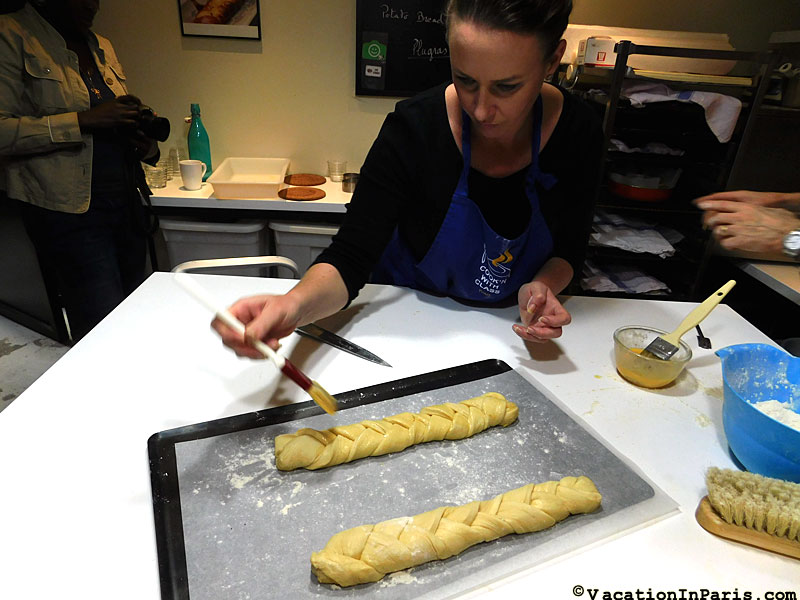
There was something physical and yet delicate about making these breads, requiring just the right touch. I did not have the French touch. My baguette turned out bumpy, and the braided legs of my praline brioche were messy compared to everyone else’s.
Now it was time to make pate feuillété, the dough used for croissants, France’s greatest invention (though the croissant originated in Austria, it became famous in France.) Patrick took out a thick slab of chilled butter, hard as a rock, then beat it with the rolling pin. He then rolled it into a paper-thin sheath, which we layered over the dough. We watched as he folded it again and again, rolling it out each time, until there were 80 layers total, that’s 40 layers butter, 40 layers dough, thinly rolled out and refolded!
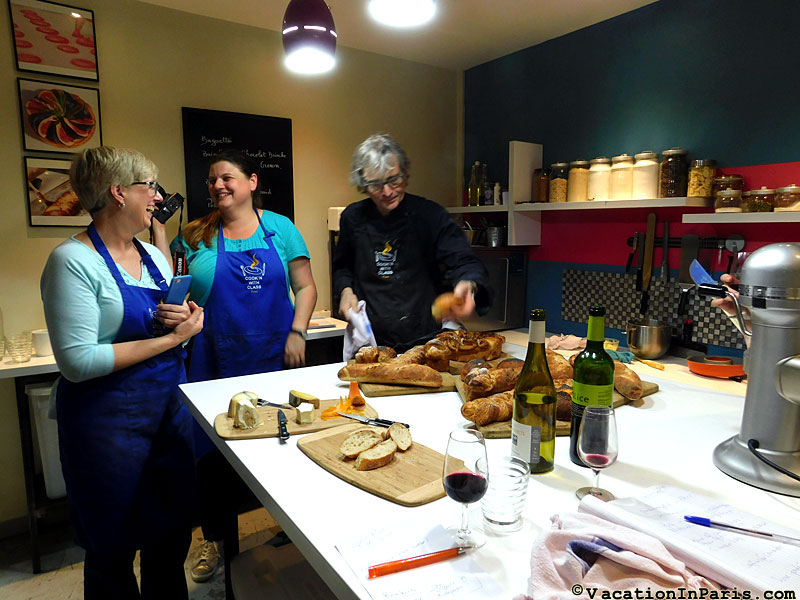
I couldn’t help thinking about the metaphors for life that bread making was bringing up in my head. The chemistry, the tension, the force, the delicacy when needed, the precision required, the skills, and the final outcome - taste and beauty. It’s this perfection in the sensual domain where the French prevail. You name it: food, fashion, perfume, wine; the French are one of the best.
As we spread delicious hazelnut cream over the rolled out brioche dough, and brushed egg wash between the rolls of brioche to make them stick, Patrick began putting the baguettes in the oven. To make the outer crust crunchy, he added water into the oven, spraying it over the top of the baguettes to create steam. It was already 11:30am.
What a surprise when Patrick brought out two bottles of wine and a platter of five kinds of cheese! Delicious French Chardonnay and a red Corbières that was out of this world it was so good. This gave us a chance to talk. The Australian woman had signed up for a week of classes at Cook'n With Class. Her eyes lit up as she told me one of her favorites was the Chef’s Table - Food & Wine Pairing, a 5-course meal prepared by a Cook'n With Class chef. As you dine on five incredible dishes the chef explains the relationship between the tastes. They also offer macaron classes, dessert classes, French sauce classes, and lots more. It’ll be a hard decision to know what to take next.
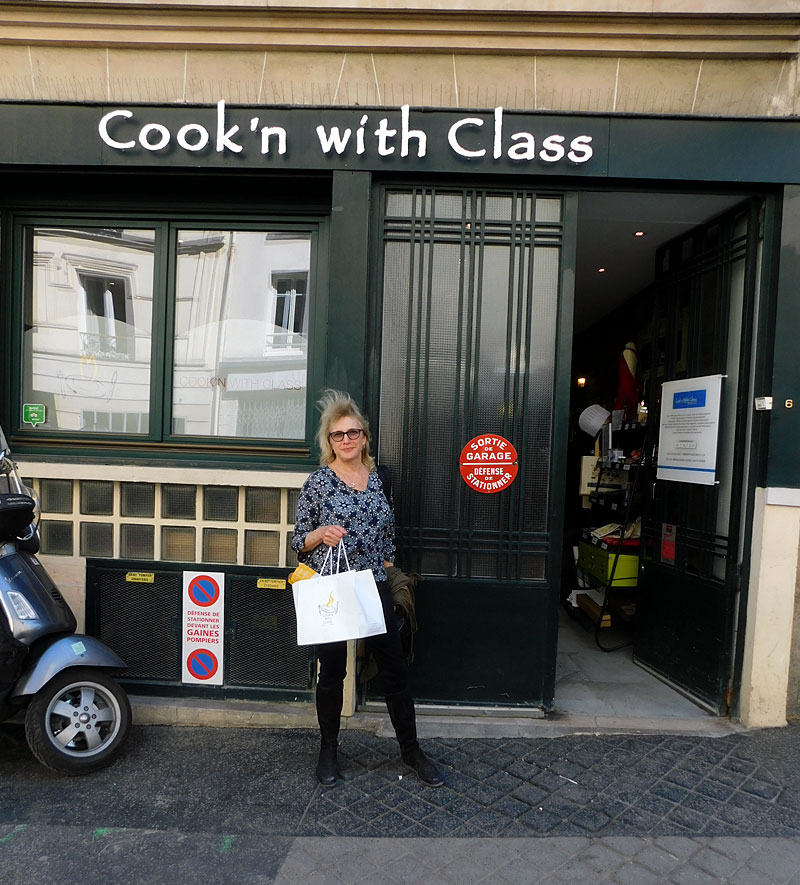
Soon Patrick pulled everything out of the oven for us to taste and made us each a bagful to take home. I’ll still never be a natural cook, but what a great way to spend a Monday morning.
By Mary Thompson, our local Parisian
Cook'n With Class - Celebrating 10 years in 2017
Monday - Saturday open year round
6 rue Baudelique, Paris 75018
www.cooknwithclass.com/paris
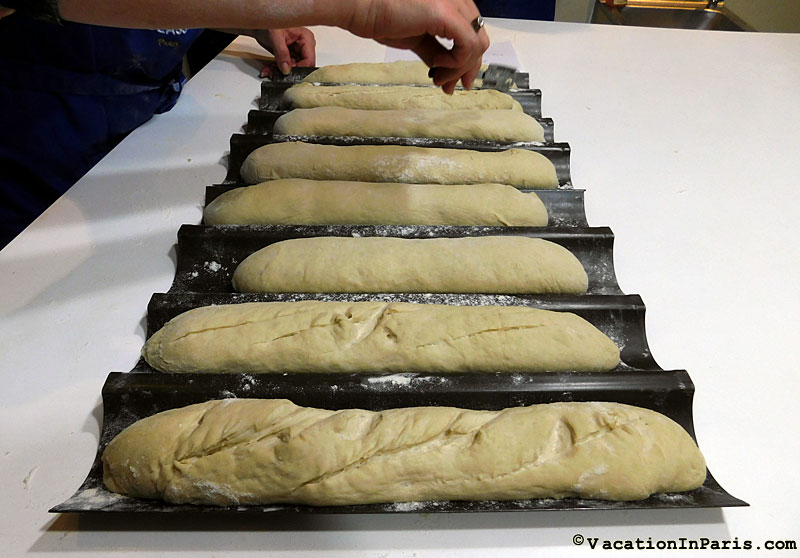

© 2017 Vacation In Paris
Site by: J.E.G. Design, Inc.













